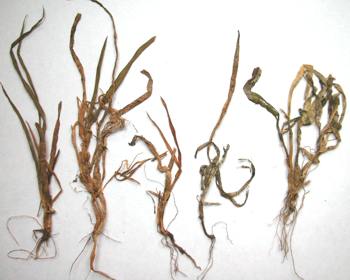Diseases
Typhula incarnata Lasch: Fr., T. idahoensis Ramsb. - Typhula Blight, Speckled Snow Mold
Systematic position.
Class Basidiomycetes, subclass Holobasidiomycetidae, order Aphyllophorales, family Claviriaceae, genus Typhula.Synonyms.
T. incarnata Lasch: Fr. = T. elegantula P. Karst., T. itoana Imai., T.graminum Karst.; T. idahoensis Ramsb. = T. boreales M. Chochr.Biological group.
Hemibiotrophic wheat pathogen.Symptoms of disease.
Typhula Blight appears after snow melting on winter wheat seedlings and on adjacent soil as dark gray fungal spawn. Affected leaves lose green color, turn brown, and droop. Gray-white mycelia develop in leaf axils, nodes of tillering become crumpled, being easily separated from roots. Sclerotia are observed on macerated plants and on soil surface.Biology and morphology.
In summer sclerotia are located in soil or plants debris. They germinate in fall and a felty white fungal mat forms over the plants. New sclerotia form on pathogen mycelia between sheaths in the crown and on the surface of dead leaves and on the soil surface nearby roots. Winter wheat is infected by basidiospores or infectious hyphae in autumn. Sclerotia of T. incarnata are irregularly shaped, red to dark brown, rough, 0.5 to 4.5 mm in diameter; those of T. idahoensis are more or less round, to 1.5 mm in diameter, dark brown to black. Sometimes sclerotia form basidia under diffuse light in the ultraviolet spectrum. Basidiospores of T. incarnata are elliptic, uncolored, 7-11 x 2.5-5 mkm in size; those of T. idahoensis are ovate to elliptic, 8-14 x 3.8-8 mkm in size.Distribution.
The Speckled Snow Mold of winter wheat occurs in a complex together with other snow molds (Pink and Sclerotinia Snow Molds). The disease is registered in Central (Moscow, Tver., Smolensk, Ivanovo, Vladimir, Kaluga Regions), North-West (Leningrad Region), Volga-Vyatka (Kirov Region), Middle Volga (Penza Region), and Ural (Bashkortostan) areas of Russian Federation, in Estonia, Latvia, and Lithuania also.Ecology.
Sclerotia germinate at temperature 2 to 10.C in upper layer or on surface of soil. Sclerotia vitality keeps two years, but at the end of this period the probability of their germination decreases.Economic significance.
Typhula spp. develops on winter wheat, rye, and wild cereals. The disease reduces wheat yields because of plants maceration and tillering capacity and spike productivity decrease. Protection measures include crop rotation, autumn ploughing, application of phosphorus fertilization, and cultivation of resistant varieties.Related references:
Andreeva N.F., Tupenevich S.M. 1963. Mold diseases of winter cereals // Rasprostranenie vreditelei i boleznei s.-kh. kultur v USSR v 1963 godu (Trudy Vsesousnogo nauchno-issledovatelskogo instituta zashchity rastenii).- Leningrad -P.159-160 (in Russian).Artem.eva N.N., Bushkova L.N., Grisenko G.V. et al. 1969. Powdery Mildew and other cereal diseases// Rasprostranenie vreditelei i boleznei s.-kh. kultur v USSR v 1966 godu (Trudy Vsesousnogo nauchno-issledovatelskogo instituta zashchity rastenii).- Leningrad.- V.34.-P.60-164 (in Russian).
Distribution of diseases of grown crops in the USSR in 1968-1972.-Leningrad: VIZR. -1973.-P.48-49 (in Russian).
Distribution of pests and diseases of grown crops the USSR in 1966 and prediction of their appearance in 1967.- Moscow: Rossel.khozizdat. -1967.- P.81-83 (in Russian).
Distribution of pests and diseases of grown crops in the USSR in 1967 and prediction of their appearance in 1968.-Moscow: Rossel.khozizdat.- 1968.- P.60-63 (in Russian).
Ishkova T.I., Berestetskaya L.I., Gasich E.V., Vlasov D.Yu. 2001. Methodical instruction for diagnostics of major cereal fungal diseases. St.Petersburg: VIZR, P. 22-24 (in Russian).
Kask K.P. 1962. Typhula Blight of winter cereals in Estonian SSR//Kratkie itogi nauchnykh issledovanii po zashchite restenii v Pribaltiiskoi zone SSSR.- Riga.- P.95-96 (in Russian).
Polityko P.M. 1988.Typhula Blight on cereal crops //Zashchita rastenii.- N12.-P.18 (in Russian).
Potatosova E.G. 1960. Typhula Blight of winter cereals // Trudy Vsesousnogo instituta zashchity rastenii.-V.14.-Leningrad.- P.135-142 (in Russian).
Sanin S.A. 2000. To increase the level of phytosanitary safety of the country// Zashchita rastenii i karantin.- N12.-P.3-7 (in Russian).
Seraya L.G. 2001. Typhula ishikariensis S. Imai is a pathogen of the Speckled Snow Mold: biology, ecology, pathogenesis and substantiation of protection measures//. Avtoreferat dissertatsii na soiskanie uch. st. kand. biolog. nauk. - Moscow. - 20 pp. (in Russian).


